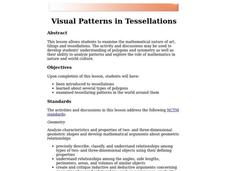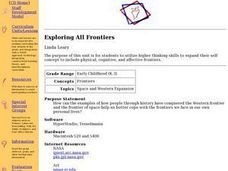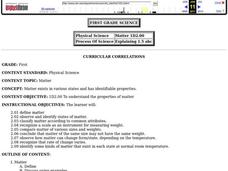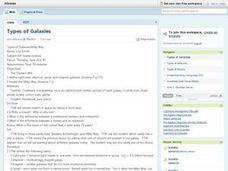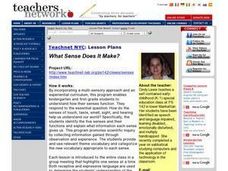Curated OER
Animal Research Project
First graders are introduced to the topic of researching by the librarian. Using a worksheet, they use various sources in the library to choose one animal from various groups. They complete a fact sheet on each animal and report their...
Curated OER
Colored Dots 1
Students observe that colored markers are a mixture of many different colors by performing a chromatography experiment. They make observations, record information, and make generalized inferences from their observations.
Curated OER
Plastic Wrap
Young scholars compare the price and quality of different kinds of plastic kitchen wraps and then rank them from best to worst. They take into account how well it comes out of the roll, if it seals well, it is tangles, how much weight...
Curated OER
Visual Patterns in Tessellations
Students explore tessellations as well as various types of polygon. Students examine tessellating patterns in the world around them. Students examine tessellations by creating their own tessellations and completing the included worksheet.
Curated OER
An Introduction to Quadrilaterals
Students explore different types of quadrilaterals. Students define the terminology used with quadrilaterals. They create particular quadrilaterals based on specific characteristics of the quadrilaterals using an online tool.
Curated OER
Trekking to Timbuktu: The Search for Timbuktu
Students explore the factors that contributed to the decline of Timbuktu and the myths and misconceptions about the city. Students study the obstacles that made a journey to Timbuktu a difficult one as well as discover the first European...
Curated OER
Exploring All Frontiers
Students utilize higher thinking skills to expand their self concept to include physical, cognitive, and affective frontiers. The teacher create activities which allow students to use raw data and primary sources, as well as...
Curated OER
Matter
First graders study and define matter. They observe and identify states of matter along with common attributes and study how matter can change form or change its state depending on temperature.
Curated OER
Ecosystems: Biotic and Abiotic Factors
Seventh graders examine proper journaling techniques, and record observations about at tree after listening to a read aloud of "Four Worlds: The Dine Story of Creation." They study the difference between living and non-living things, and...
Curated OER
Marshland Wonders
Students review the characteristics of wetlands and list their benefits. After viewing short videos, they identify the organims that make their home in wetlands and how they have adapted. They compare and contrast the characteristics...
Curated OER
Following the Great Wall of China
Students explore the Great Wall of China. They participate in three activities to become familiar with the geography of China and Chinese names. Students explore the size of the wall by examining an interactive web site. They write a...
Curated OER
On the Road with Marco Polo: Crossing the Deserts of China
Students explore the geography of China. They describe the geography of the Taklimakan. Students discover the best route to travel from one end of the desert to the other. They investigate how some of the local inhabitants make a...
Curated OER
BREAD IN A BAG
If possible, acquire a handful of wheat kernels from a local farmer or seed dealer. Hand them out so young scholars can feel them and see what they look like. Share background information. 2. Draw a wheat kernel on the chalkboard, or use...
Curated OER
Types of Galaxies
Eighth graders take a quiz to review the different objects in space. As a class, they define terms related to galaxies. In groups, they make a model of the Milky Way galaxy using materials provided to them by their teacher. To end the...
Curated OER
The Unit Circle
Learners relate the trigonometric functions to the coordinates of the unit circle with access to explorelearning.com. They determine the signs of trigonometric functions in each quadrant.
Curated OER
What Sense Does It Make?
Learners identify the five senses and their functions and explain what information each sense gives us. They collect information gained through observation and experiences. They practice identifying new vocabulary words from the word wall.
Curated OER
CSI Clamshell Investigation
Pupils explore and explain how moon snails eat and where the holes in clamshells come from and then draw conclusion from the data collected. They incorporate math and graphing skills to determine if there is a relationship to a clam's...
Curated OER
Pollination Partners
In this science worksheet, students look for the causes and effects of pollination through doing some arts and crafts projects that includes a collage.
Curated OER
Biologically Important Molecules
In this biologically important molecules worksheet, students fill in the blank with information about carbohydrates, lipids, and proteins. Students also make notes about nucleic acids.
Curated OER
The Euglena
In this euglena worksheet, students read information about these unicellular organisms. Students then color in the different structures of the euglena on a diagram. Students complete 10 short answer questions.
Curated OER
Making Pretzels
Young scholars discover that plants provide food products to humans. For this baking lesson, students grind wheat seeds into flour and then use the flour to make pretzels. Young scholars participate in a variety of activities that...
Curated OER
Donut Sort
Third graders create dichotomous keys using donuts. For this dichotomous lesson, 3rd graders review what a property is and sort donuts by a specific property. Donuts are kept in plastic baggies for the activity so they can be enjoyed by...
Curated OER
Long a Vowel Phoneme
For this long a vowel phoneme worksheet, students cut out the 35 word cards featuring the long a sound. Students sort the 35 cards into groups based on the patterns that make the long a sound.
Alabama Learning Exchange
Three in a Row Calendar Game
Students explore a calendar. In this calendar and math instructional activity, students view a video clip about using a calendar. Students participate in a game in which a game board is used to identify days of the week, dates, and months.





